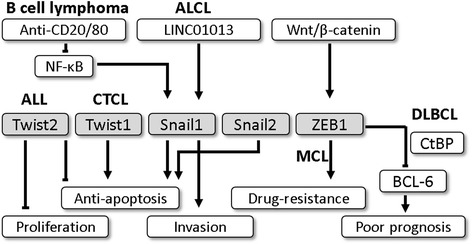Fig. 2.

The role of epithelial-mesenchymal transition-transcription factors in lymphoid malignancies, In lymphoid malignancies, Twist1 is overexpressed in Sezary syndrome (SS), a rare cutaneous T cell lymphoma (CTCL), and its expression may be associated with anti-apoptotic effects. In contrast, the expression of Twist2 inhibits tumor growth and induces apoptosis in acute lymphoblastic leukemia (ALL). In B cell lymphoma, NF-κB and the upregulation of Snail1 promote lymphoma cell resistance to apoptosis, whereas anti-CD20 and anti-CD80 monoclonal antibodies reverse the effect. Moreover, non-coding RNA LINC01013 activates Snail1 and enhances the invasion ability of anaplastic large-cell lymphoma (ALCL). Snail2 has anti-apoptotic activity during lymphoid development. In diffuse large B cell lymphoma (DLBCL), the Wnt/β-catenin signaling pathway induces the expression of ZEB1, which cooperates with CtBP to inhibit Bcl-6, leading to the poor prognosis of B cell lymphoma. Similarly, Wnt signaling induces ZEB1 expression in a mantle cell lymphoma cell line and makes MCL cells resistant to chemotherapy
